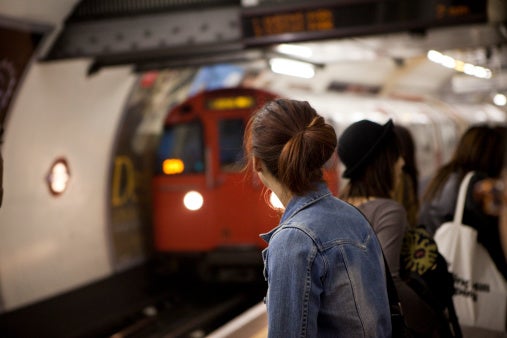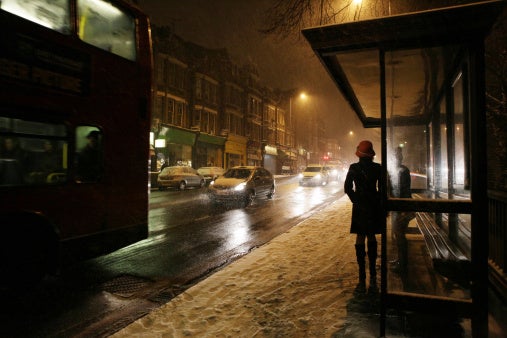Sexual harassment on public transport is a problem we must solve
A new study has revealed women across the world feel unsafe when taking public transport, with one in three London women reporting abuse on the tube

Your support helps us to tell the story
From reproductive rights to climate change to Big Tech, The Independent is on the ground when the story is developing. Whether it's investigating the financials of Elon Musk's pro-Trump PAC or producing our latest documentary, 'The A Word', which shines a light on the American women fighting for reproductive rights, we know how important it is to parse out the facts from the messaging.
At such a critical moment in US history, we need reporters on the ground. Your donation allows us to keep sending journalists to speak to both sides of the story.
The Independent is trusted by Americans across the entire political spectrum. And unlike many other quality news outlets, we choose not to lock Americans out of our reporting and analysis with paywalls. We believe quality journalism should be available to everyone, paid for by those who can afford it.
Your support makes all the difference.This piece was co-authored by by Laura Bates
Ask a man his number one priority when it comes to public transport. Most likely he will say ‘speed’. Ask a woman the same question and chances are that she will answer ‘safety’.
Sexual harassment on public transport is an everyday occurrence for millions of girls and women living in some of the world’s biggest capitals.
From verbal abuse to being followed, from unwanted sexual comments to physical assault, the stories are strikingly similar, regardless of the geography. And while some governments around the world are beginning to take a tougher stand against issues like domestic violence, sexual harassment in public spaces remains a largely neglected issue.
A poll released today by the Thomson Reuters Foundation in partnership with YouGov reveals that 32% of women in London say they have been verbally harassed on public transport; 19% were victims of direct physical abuse. The global ranking puts the safety of London’s transport system behind that of New York, Beijing and Tokyo, but ahead of Paris, where 85% of the women polled expressed little confidence in receiving help by a member of the public if they were in trouble. The worst capitals are those in Latin America, where six in every 10 women reported being physically assaulted on buses and trains.
These numbers are worrying, especially because women are the main users of public transport in most metropolitan areas around the world. The figures are also particularly alarming because fear has dramatic consequences for women’s behavior: if they feel that going somewhere would put them at risk, in many cases, women won’t go. In some countries, this translates into girls missing school, women giving up job offers, or even being unable to access essential healthcare services. In India, where 5.5 million women enter the workforce each year, more than 50% express high concerns about the safety of their commute.
Despite the high levels of incidents, sexual harassment remains mainly unreported. Women tend not to report the majority of incidents, sometimes amid concerns that they would not be taken seriously. A TfL survey conducted last year revealed that 15% of women and girls had experienced unwanted sexual behaviour on the London transport network, but 90% of them had not reported it.
To break the silence, over the past two years, the Everyday Sexism Project has been collecting more than 80,000 stories of ordinary women living across the world who have been the victims of sexual violence and sexual harassment. Several thousands of these accounts relate to incidents taking place on the transport network, with cases ranging from young girls being photographed against their will, to women witnessing public masturbation.
A number of cities are taking the lead in addressing the issue. In 2012, Boston launched a powerful campaign aimed at encouraging women to speak up. London followed suit in September 2013 with Project Guardian, a collaborative effort by the British Transport Police, the Metropolitan Police, the City of London Police and Transport for London, to boost levels of reporting of sexual offences.
The Everyday Sexism Project, the End Violence Against Women coalition and Hollaback advised the police on the project, which saw 2000 officers receive special training and 120 officers - both in uniform and plain clothes - carry out daily patrols on the transport network. Since the launch of the initiative, there has been a 20% increase in the reporting of sexual offences, and a 32% increase in the number of cases where offenders have been charged or summoned.
Some cities are using bold initiatives to counter sexual harassment on public transport. Last year, Delhi committed to a huge financial investment to introduce CCTV and special alarm buttons across most of the transit network, and Osaka introduced women’s only carriages for its train system. London is considering the same option. 45% of the women polled by the Thomson Reuters Foundation endorse the idea saying it would make them feel safer.
But women-only carriages are surely not the ideal solution. Shouldn’t public money be spent to tackle the real root of the problem, which is sexual discrimination and assault? Wouldn’t that achieve a better and lasting impact? The behaviour of perpetrators should be tackled, rather than the freedom of victims curtailed.
And then there’s the issue many refuse to see: worldwide, women and men use public transport in different ways. Their roles, needs and priorities are different. Unlike men who tend to move from point A to point B and back, women’s travel patterns may be less regular. On a daily basis many travel to childcare, school, work, shops and home. Some of this travel takes place at times when fares are the highest, which means that to avoid substantial costs some women decide to travel off-peak, when streets are dark and transit points are more prone to crime.
Women are the major users of public transport in all metropolitan areas around the world, yet they have very little say when it comes to the planning of transport routes, fares and – crucially – safety. Not only this is wrong from a diversity standpoint, it also makes no business sense at all. In addition, when women are subjected to harassment and assault on public transport, the reaction sometimes centres wrongly on the victim instead of the perpetrator, with the discriminatory suggestion that they shouldn’t have been travelling alone, or at certain times of day.

So, here’s the good news. We believe that a few simple steps could be easily introduced to reduce the chances of women becoming victims of sexual violence. Among them, the creation of a ‘request stop’ scheme, allowing women to get off closer to their destination late at night and early in the morning; better-lit bus stops, more buses and trains on the road at night, to boost the frequency of service and to reduce waiting time at transit points.
And then, of course, there is the need to consult and to involve women in the decision-making process. Refusing to do so will only produce transport networks that are unsafe, less reliable and potentially more costly. Victims should be encouraged to feel able to report harassment and assault on transport networks. Increased reporting would identify hotspots where targeted patrols could help to tackle the problem. Most importantly of all, decisive action must be taken against perpetrators to send the clear message that these crimes are unacceptable.
Women, like men, have the right to feel safe and to live freely in their cities. Let’s make that a priority.
Safety for women in the cities is one of the themes of the upcoming Trust Women Conference 18-19 November in London. Visit trustwomenconf.com.
Join our commenting forum
Join thought-provoking conversations, follow other Independent readers and see their replies
Comments